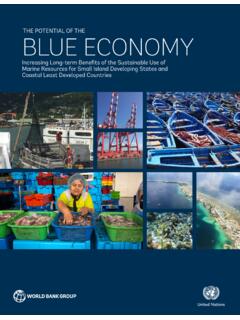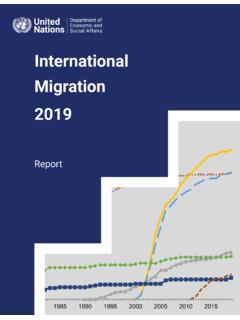Transcription of Chapter III Towards sustainable cities - United Nations
1 Chapter III. Towards sustainable cities Summary yy Numerous challenges threaten the ability of cities to become viable pillars of sustain- able development. Unequal access to, and inefficient use of, public services, as well as financial fragility and the harm inflicted by natural hazards, demand an integrated and coordinated response at the local, national and international levels. yy The predominance of small- and medium-sized cities provides an opportunity to invest in green infrastructures, bypassing old energy technologies, and in social deve lopment, before social inequities become unsustainable.
2 Yy Rural development is critical for an integrated approach to sustainability and for reducing poverty. Ensuring wider and inclusive access to public services can reduce rural/urban inequalities, disaster risk and food insecurity, as well as strengthen net- works between cities and villages. yy Building sustainable cities requires investment in (a) renewable energy sources, (b) ef- ficiency in the use of water and electricity, (c) design and implementation of compact cities , (d) retrofitting of buildings and increase of green areas, (e) fast, reliable and affordable public transportation and (f ) improved waste and recycling systems.
3 cities in poor countries need resources to support green technology transfer, and capac- ity development, and to improve access to soundly constructed housing, water and sanitation, electricity, health and education. Introduction cities and towns have become the primary human living space. Since 2007, more than half of the world's population has been living in urban areas and the figure is estimated to exceed 70 per cent by 2050. This is a hallmark of the transformation of humans' economic base and social structure, inasmuch as, previously, populations lived and worked primarily in rural areas.
4 cities can provide many socioeconomic benefits. By concentrating people, investment and resources (a process known as agglomeration), cities heighten the pos- sibilities for economic development, innovation and social interaction. More specifically, cities also make it possible to lower unit costs so as to provide public services such as water and sanitation, health care, education, electricity, emergency services and public recrea- tional areas (Pol se, 2009; Satterthwaite, 2010). However, this requires a functioning city 54 World Economic and Social Survey 2013.
5 Government able both to ensure that such benefits are realized, and to adopt a sustainable framework that encourages the city's growth within ecological limits. Along these lines, cities also face challenges that threaten their efforts to achieve sustainability, for example, through improvement of access to, and efficiency in the use of, public services, as well as reduction of their ecological footprint and financial fragility, and the building of resilience against the adverse impact of natural hazards. The present Chapter recommends an integrated strategy for making cities thriv- ing centres of sustainable development and innovation.
6 It starts by assessing what a city is, the scale and speed of urbanization in recent decades, and the main trends and projections of urban growth across regions. The trends and projections analysed serve as an introduction to the conception of future urbanization as a process that can enhance the benefits of cities , while reducing the threats to a more balanced and sustainable development. The evolution of the concept of urban sustainability is described and a framework is proposed based on four pillars: economic development, social development, environmental management and effective urban governance.
7 The following section examines relevant challenges associated to the fulfilment of those objectives by different groups of countries. The last section examines urbanization through the lens of the investment opportunities that addressing those chal- lenges involves. A proposal put forth for an integrated set of investments in infrastructure, public services and capacity development is complemented by an examination of relevant world experiences associated with urban sustainability at the sectoral level ( , disaster risk reduction, housing and green infrastructure) as well as a policy framework for a sustainable financing of cities .
8 The city and main urbanization trends There is no uniform definition of what constitutes a city, given the diversity of urban realities around the world. Every country defines cities according to its own criteria. It should also be noted that gaps in and measurement issues connected with urban data limit the accuracy of projections and international comparisons of levels of urbanization and sizes of city populations. Box discusses the different criteria used in defining cities and data issues. cities are diverse in terms of their size, structure, spatial form, economy, wealth, local resources availability and ecological impact.
9 According to population size and conditions, urban centres can be, , small, medium, large or mega. The popula- tion of an urban centre can range from a few thousand to over 10 million people or more. According to relevant studies, small urban centres have a population less than or equal to 500,000 people; medium urban centres, a population between 1 million and 5 million people; and mega urban centres, a population of 10 million or more ( United Nations , Department of Economic and Social Affairs, Population Division, 2012; Dobbs and others, 2011b). For statistical comparison of urban centres' sizes and development, this Chapter uses the categories along with large urban centres defined as agglomerations with 5 million inhabitants or more.
10 By 2050, the world urban population could reach billion, 80 per cent The scale and scope of urbanization of whom would live in developing regions, and At the start of the twentieth century, just 16 cities had 1 million or more people, with the concentrated in cities of majority located in advanced industrialized countries (Montgomery and others, 2004). By Africa and Asia 2010, there were 449 cities with 1 million people or more, of which three quarters were Towards sustainable cities 55. Box Definition of a city and data issues The majority of countries use a single characteristic or a combination of administrative, population size or density, economic and urban characteristics ( , paved streets, water-supply systems, sewer- age systems and electric lighting) to define a city.











